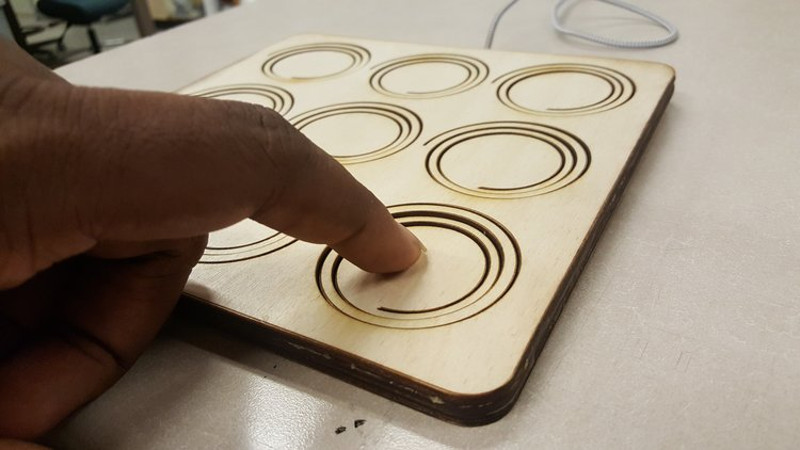We see a huge variety of human-computer interface devices here at Hackaday, and among them are some exceptionally elegant designs. Of those that use key switches though, the vast majority employ off the shelf components made for commercial keyboards or similar. It makes sense to do this, there are some extremely high quality ones to be had.
Sometimes though we are shown designs that go all the way in creating their key switches from the ground up. Such an example comes from [Brandon Rice], and it a particularly clever button design because of its use of laser cutting to achieve a super-slim result. He’s made a sandwich of plywood with the key mechanisms formed in a spiral cut on the top layer. He’s a little sketchy on the exact details of the next layer, but underneath appears to be a plywood spacer surrounding a silicone membrane with conductive rubber taken from a commercial keyboard. Beneath that is copper tape on the bottom layer cut to an interweaving finger design for the contacts. An Adafruit Trinket Pro provides the brains and a USB interface, and the whole device makes for an attractive and professional looking peripheral.
You can see the results in action as he’s posted a video, which we’ve included below the break.
We’ve shown you spiral structures for flexibility in the past, with flexible materials made via 3D printing.















A double (or better triple) spiral would probably help with the buttons torquing in turn causing inadequate closure of the circuits underneath
Yo that’s perfect, I love getting feed back from the community woot woot never thought of a double spiral
Add 4 LEDs per button under and you would even have feedback as the light could shine through the slits.
The single spiral seems to works well too.
why so angry reaction? Double or triple spiral was even for me the first thing I would do, because it looks better and probably it will behave better…
What on earth made you think that post was angry??
Feet so that it sits flat on the surface would probably make a huge difference too. hard to press something that’s moving.
You can also use Piezo transducers for the triggers. However the circuit is a bit more complex , but would allow pressure sensitivity to be used as a drum controller etc.
Hmm, wouldn’t that crack the piezo? I’m thinking of those old digital watch piezo elements…
You can do trigger velocity with a piezo but not continuous pressure like typical aftertouch.
Genius!
I will second the double spiral concept. A friend did the same in 2014 for a front panel made of 1/18″ extruded acrylic on a 1/4″ MDF enclosure. The prototype enclosure needed to be “strong”, but also needed some flush user interfaces. The 1/8″ acrylic was inlaid into one side of the MDF and double spiral living hinge style buttons were used to activate micro-switches internally. A second layer of MDF was behind the acrylic so that the buttons could only be depressed about an 1/8″, which was just enough to activate the micro-switches, but not stress them. It worked fantastic and I really want to put the same style buttons on something I make. The MDF was painted with a “hammered metal” paint so it looked really slick.
The concept of making it work like an actual membrane switch is very clever. Using a Snaptron Snapdome under the spiral button would be another way to make it just like a tactile switch, but still super thin.
This seems like an ideal teaching opportunity to learn about other shapes of flexures
Great idea. Maybe even do a (musical) keyboard with rectangular spirals. If the key backs had some kind of resistive properties (spray on stuff), then “maybe” it could be pressure sensitive too? Or, use this above something like a TPP223 capacitive touch sensor (maybe a capacitive sensor could be made “pressure” sensitive?). These could also be CNC cut.
super cool ! have fun and all fingers !